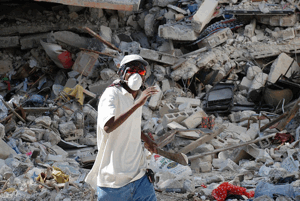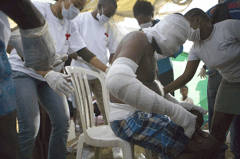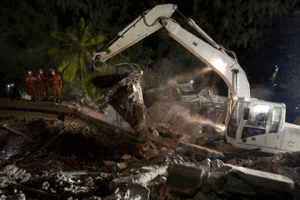Rebuilding Haiti from the Roots Up
Air Date: Week of January 22, 2010

Dominican Red Cross attend to Jean Reneau Beoubuer in Cite Soleil. (Photo: Talia Frenkel, Courtesy of American Red Cross)
Haiti’s long-standing environmental crisis has amplified its current humanitarian crisis. Marc Levy, deputy director of the Center for International Earth Science Information Network at Columbia University, had been working to alleviate poverty, hunger and landslide vulnerability by restoring the island nation’s ecosystem. He tells host Jeff Young what Port-au-Prince was like during the earthquake and how national rebuilding efforts need to include an ecological plan.
Transcript
(THEME)
YOUNG: From the Jennifer and Ted Stanley Studios in Somerville, Massachusetts – this is Living on Earth. I’m Jeff Young. Since January 12th the world has watched in horror the news coming out of Haiti. The earthquake added unfathomable suffering to a nation already beset by poverty, political upheaval and environmental degradation. Columbia University political scientist Marc Levy was in Haiti when the earthquake hit--at the U.N. Development Program’s compound in Port-Au-Prince.
LEVY: I personally first thought that we were under armed attack. After ten seconds or so, it was fairly evident that we were experiencing an earthquake. Fortunately, where I was suffered only modest structural damage. The scene outside the compound was in stark contrast to what we were experiencing – very severe damage, cars crushed, buildings collapsed, lots of injuries, chaos. And so a lot of people were let in to be given immediate first aid – several hundred people eventually.

A man in front of the pile of rubble that once was the Université Caraibes. (Photo: Eric Quintero, Courtesy of IFRC)
YOUNG: Professor Levy is with Columbia’s Earth Institute, which is working with a U.N. program in Haiti motivated by the disastrous flooding during 2008’s tropical storms. The Haiti Regeneration Initiative aims to address the twin challenges of political strife and natural disaster and the ecological conditions that underlie those problems.
LEVY: Haiti is a place that has experienced both political instability and natural disasters. This particular program was extremely ambitious – the aim was to get beyond the kind of patchwork, short-term, ad-hoc type of foreign aid that’s characterized the country in the past, and to think big, to think in light of the kind of new optimism that was present over the last year with regard to Haiti that we could really do something different. And the idea was to design principles that could be implemented that would achieve reforestation, lessening of the hurricane risk, and improvements in soil fertility across the entire country.
YOUNG: What becomes now of those programs like the one you were engaged in that were starting to show some early green shoots, some early signs of promise?

Dominican Red Cross attend to Jean Reneau Beoubuer in Cite Soleil. (Photo: Talia Frenkel, Courtesy of American Red Cross)
LEVY: Clearly, everything is different now; nobody can pretend that they can pick up the pieces where they left off. This is a complete life-changing moment for absolutely every single Haitian, and for every single person working in the country.
In our particular case, the connections between the urban poor and the countryside are so strong, and the connections between the deforestation, soil erosion and flooding risks and these seismic risks are so strong that we think the overall framework is still deeply relevant – we’re just implementing it in different ways.
YOUNG: How did Haiti’s ecosystem become so degraded anyway? Dominican Republic, their neighbor there on Hispaniola, there’s a stark difference written in the trees, themselves. The political boundary is visible in trees on one side and the lack of them on the other. How did Haiti end up on the path it did; and what lessons should we take from that as we look ahead?
LEVY: The initial colonial history was one in which a very large number of slaves were brought in by the French, so that from the very start the population density in Haiti was much larger than in the Dominican Republic.

The visible border between Haiti and the Domincan Republic. (Courtesy of NASA/Goddard Space Flight Center Scientific Visualization Studio)
And they engaged in cultivation practices that resulted in significant and fast deforestation, lots of trees exported back to Europe, and then when the French were thrown out, the Haitians were left with a very large population with a very weak resource base from which any group of people would find it very hard to recover.
YOUNG: How does Haiti’s ongoing environmental crisis feed into the humanitarian crisis that we see now?

The United Nations on a search-and-rescue mission of its headquarters in Port-au-Prince. (Photo: Logan Abassi)
LEVY: Well, in a number of ways. One is simply that the country is extremely poor – two thirds or so of the country still makes its living in the countryside, but the countryside is extremely ill-suited towards providing livelihoods for people because of the centuries of mismanagement.
The corn, which is one of the basic crops, has got a yield in Haiti of 800 kilograms per hectare, which is extremely low – among the very lowest in the entire world, it’s about half of what it is in the rest of South America, it’s about a tenth of what it is in the United States.
YOUNG: So, if we have upwards of 60 percent of Haitians who depend on the land, how can something directed at environment restoration help make their dependence on the land more sustainable?
LEVY: Well, what’s going on now is that they’re getting less and less value from the land year after year. The trees are getting cut down; they suffer regular traumatic damage from the storms. We visited an area in the southeast of the country last year, and numerous families that we talked to had their entire crop wiped out during the 2008 hurricanes. So, by reforesting, by channeling the stream so that the floods are less severe and the soil erosion is lessened, crop losses go down.
YOUNG: And, how does the relationship to the land affect what happens with the growth of the cities? I’m guessing people, their crop gets wiped out they may be left with no choice but to end up in, say, a shanty in Port-au-Prince?
LEVY: Yep, that’s exactly right. A number of the families responded to the 2008 disasters by moving into the cities. The reverse of what’s going on now. And that puts more pressure on the cities where the jobs are very scarce, and so they move from one type of misery to another.
YOUNG: You know, it was not that long ago, just under two years ago, we were talking about disastrous flooding in Haiti linked to deforestation and tropical storms hitting the island. Chances are many of the people displaced by this earthquake will remain displaced and in temporary shelters for months. Hurricane season is not that far away – how does that concern play into how you deal with the displaced people here?
LEVY: Well, I think there’s a couple of elements that are going to be very worrisome. One is that the countryside is already barely able to provide minimal living standards for people. And if some of these places become flooded with an increased number of people, and then those regions become stressed through severe storms or hurricanes, they could limit the coping capacity quite a bit, or put more people at risk.
Another danger is that you may get new settlements in places that people have historically avoided because they were dangerous. But people are potentially fleeing there because they feel like they have no choice, and we have to carefully monitor whether people are starting to settle in areas where flooding from landslide risks may be high in the coming months.
YOUNG: Marc Levy’s deputy director of the Center for International Earth Science Information Network at Columbia University. Thanks for your time.
LEVY: Thank you.
YOUNG: Professor Levy says he’s going back to Haiti to continue the Regeneration Initiative. You can learn more about that program and other efforts to restore Haiti’s environment at our website, l-o-e dot org.
Links
Living on Earth wants to hear from you!
Living on Earth
62 Calef Highway, Suite 212
Lee, NH 03861
Telephone: 617-287-4121
E-mail: comments@loe.org
Newsletter [Click here]
Donate to Living on Earth!
Living on Earth is an independent media program and relies entirely on contributions from listeners and institutions supporting public service. Please donate now to preserve an independent environmental voice.
NewsletterLiving on Earth offers a weekly delivery of the show's rundown to your mailbox. Sign up for our newsletter today!
 Sailors For The Sea: Be the change you want to sea.
Sailors For The Sea: Be the change you want to sea.
 The Grantham Foundation for the Protection of the Environment: Committed to protecting and improving the health of the global environment.
The Grantham Foundation for the Protection of the Environment: Committed to protecting and improving the health of the global environment.
 Contribute to Living on Earth and receive, as our gift to you, an archival print of one of Mark Seth Lender's extraordinary wildlife photographs. Follow the link to see Mark's current collection of photographs.
Contribute to Living on Earth and receive, as our gift to you, an archival print of one of Mark Seth Lender's extraordinary wildlife photographs. Follow the link to see Mark's current collection of photographs.
 Buy a signed copy of Mark Seth Lender's book Smeagull the Seagull & support Living on Earth
Buy a signed copy of Mark Seth Lender's book Smeagull the Seagull & support Living on Earth

